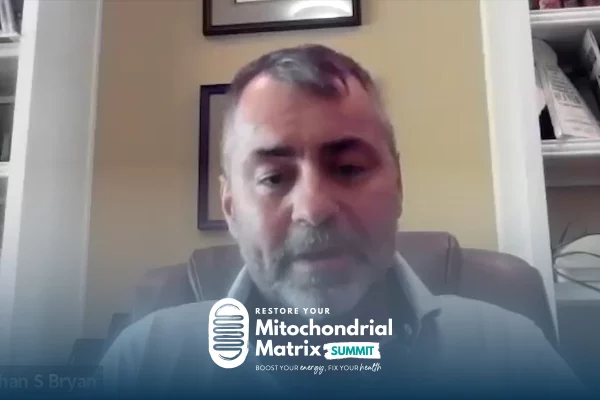Join the discussion below

Laura Frontiero, FNP-BC, has served thousands of patients as a Nurse Practitioner over the last 22 years. Her work in the health industry marries both traditional and functional medicine. Laura’s wellness programs help her high-performing clients boost energy, renew mental focus, feel great in their bodies, and be productive again.... Read More

Dr. Jaban Moore is a DC located in Kansas City, MO who works virtually with clients all around the world. At age 25, he went from being an award-winning top athlete in college to feeling like he couldn’t even get out of bed. He went to a lot of appointments... Read More
- Why it’s so hard to find parasites on a lab test
- The most common parasites and where they are located in the body
- The correlation between parasites, heavy metals and industrial toxins
- How parasites suppress and weaken your immune system
Related Topics
Autism, Chemical Toxicity Summit, Co-infections, Deworming, Dna Sampling, Food Cleanliness, Giardia, Gut Health, Heavy Metals, Lyme, Lyme Disease, Misinformation, Mitochondria, Multicellular Organism, Myth, Pandas, Pans, Parasites, Pathogens, Root Cause, Sensitivity Of Tests, Stool Samples, Strongyloides, Testing, Toxins, Veterinary Lab, VirusesLaura Frontiero, FNP-BC
Welcome back to another episode of the “Restore Your Mitochondrial Matrix” summit. I’m your host, Laura Frontiero, and I’m bringing you experts to help you boost your energy and fix your health so you can build the life you love. And today my special guest is Dr. Jaban Moore. Hi, Jaban, welcome to the summit.
Dr. Jaban Moore
Well, thank you for having me. I’m excited to talk about mitochondria, for sure.
Laura Frontiero, FNP-BC
Yeah, I am excited, too, because we’re gonna talk about something else that I love. So we’re gonna talk about mitochondria and parasites today, and this is gonna be such a vital discussion because there’s so much misinformation, myth, and just people don’t understand parasites at all. And you are so knowledgeable in this area, and I’m really excited to have this talk. So a little bit about you, you work virtually with clients all around the world. You specialize in Lyme disease and its co-infections, PANS, PANDAs, autism, heavy metals, parasites, gut health, mitochondria support, and other viruses and pathogens. And you also have something coming up really soon. You’ve got the “Chemical Toxicity Summit” that you’re hosting, so you are a busy man. I really appreciate your time today. Before we get started, can you let us know a little bit of how you got to where you are right now, and why this is such a critical topic for you to be talking about today.
Dr. Jaban Moore
Yeah, so I was a college athlete, all-American, and honestly, I graduated, I started focusing on health, lost some weight, ’cause I was a shot putter, so I was a big boy. And as soon as I got healthy, got a six-pack, I felt like my health fell out from under me. And I was just like, what? I should be healthier. I’m eating cleanly now, and I just got worse. And after the journey that so many people have gone through of finding that nobody understands why, going to tons of different doctors, trying different herbs, getting told that it’s in my head, or, oh, your joint pain or your brain fog, your erectile dysfunction, it just happens sometimes. I’m like I’m 25 years old. I do everything theoretically right.
I’m not accepting that. So no. And I ended up running into Dr. Allan Lindsley, who has become a good friend of mine, and he figured out that I had Lyme disease. And then from there, as I learned, okay, well, Lyme’s never alone. Parasites are a part of this, viruses, toxins, and parasites are a major huge part of it that not nearly enough people talk about. And that’s really what kinda led me down this path. And you just listed off things that I work with. It’s like, I went through these things myself, and I see them for clients that, yes, root cause is what we’re always looking for. But root cause doesn’t have to be one thing that can be a root cause. You can have several things that are individually root causes that you can be dealing with, and parasites are a huge portion of that.
Laura Frontiero, FNP-BC
Huge, and like I mentioned, people just don’t understand parasites. They say, “Well, I’ve never traveled to foreign countries. There’s no way I have a parasite,” which makes us all smile inwardly because parasites don’t know boundaries. So we’re gonna get into mitochondria and parasites in a few minutes here. But first, can we go into Parasites 101, and can you really just break down how common are they? That’s the first thing, ’cause people don’t think they have parasites. So how common is this problem?
Dr. Jaban Moore
Let’s just look at statistical data. The CDC says that a million people in a given year would get Giardia, single cellular organism parasite. World Health Organization has 100 million people will be dealing with Strongyloides in their lifetime, which is a nematode parasite, multicellular organism, looks like a little grain of rice, if it comes out of you, which trust me, we can flush those out of a lot of people. When you have ate no rice. You’ve ate no peas or anything that would look like this, and then they just start coming out, if you start. So they’re like, “Oh, okay, got it, that’s what that is.” So those are just two quick stats that can make it a little bit more open. That’s a million people in the United States with Giardia, 100 million people in the world. And that’s the people that they’re identifying and testing and accounting for. But then we start thinking about, okay, how many other people are dealing with this problem that aren’t being told? Because stool samples just simply don’t work, and testing for organisms, we test for what’s right here in our local area.
We don’t test for African parasites, or parasites from India or China or Mexico here in the heart of United States where I am, but we eat food from there. And that’s what people aren’t thinking about it. That’s why it’s like, oh, they’re not here. And then the other thing is you deworm. If you have a cat, you deworm it. If you have a dog, you deworm it. A horse, a cow, a goat, a ferret, whatever you have, you do deworm it. Your veterinarian makes you. They tell you to. Well, guess what? They’re probably eating food cleaner than most of us are because they’re eating from a bag that’s processed, that goes through all of its testing and gets back to you. Whereas we’re eating, I mean, shoot, I preach eat whole food organic.
Well, what does that mean? I’m eating plants that they do not test for parasites. I’m eating meat that they’re not grinding it all up and testing it for parasites all the time. Yes, you cook it, which kills some of them. But if you’re eating sushi or raw fruit and vegetables, if you’re eating meat that’s not well-done, there could be parasites in there, which means that we should be deworming ourselves twice a year, just like we do our animals and we’re just not doing it. So that’s a huge reason of why parasites are so rampant in our especially compromised mitochondria systems, compromised immune systems that we have today. And if you go to countries such as Mexico, third world countries and India, or where did I have somebody? Sri Lanka, the other day. They still do parasite cleanses on their own bodies, humans, twice a year. We in the United States, in the Midwest, we used to do it twice a year, up into the 50s and 60s on farms. And it’s just fallen out of favor, because why? “Oh, I’m too clean, I can’t have parasites.” It’s not here in the United States, we hear. There’s still dirt. They’re still dirt here. There’s still ponds here. That’s where they are.
Laura Frontiero, FNP-BC
Yeah, and parasites don’t know borders, and let’s face it, we kind of don’t have borders anymore. People travel all over the world, and people go to foreign countries. So maybe you didn’t travel to Africa, but somebody in your network of people did, and they brought parasites back over here with them, and then there’s person-to-person contact. So you talked about two, Giardia and Strongyloides, but how many parasites are there?
Dr. Jaban Moore
Thousands.
Laura Frontiero, FNP-BC
And how many do we actually test for? So there’s thousands of parasites, and how many do we actually even test for?
Dr. Jaban Moore
If you run a typical GI test, I mean the best one, maybe 20.
Laura Frontiero, FNP-BC
Yeah, and so you mentioned that GI tests aren’t even good for finding parasites. Why don’t we see them? How come they come back clean?
Dr. Jaban Moore
So there’s a multitude of answers for this. I’m just gonna run through ’em, right. One, the sensitivity of the test just isn’t great. So it’s looking for specific types of tissue. So it’s looking for eggs, usually, in a stool sample, and it’s gonna test that egg for DNA, and then we’re gonna get back this is Blastocystosis, or something like that, or Giardia. There are common ones like Giardia that we do find because that is more common to the landscape of the United States. But again, one, you’re not testing for enough of them because we are eating from everywhere. Just think about this. Most people are like, “Well, I don’t eat raw meat, I’m good.” Well, you do eat vegetables and plants that come from everywhere.
So if you’re living in Minnesota, and it’s the middle of the winter, and you’re having a smoothie bowl that’s organic that they made right there in front of you with plants. Where did that come from? It sure as heck wasn’t the United States, for the most part. It’s from all around the world. So we’re not testing for all those things. We’re not testing for those. We’re not testing always for an organism, not an egg. If you literally poop out a parasite, actually do that. Like poop, pull it out, put the parasite right on top of the sample, send it in. The technician is trained to find the ovum. So we’re gonna move that to the side. We’re gonna take a scoop of the poop. We’re gonna look for the ovum under the microscope. We’re not doing a DNA sampling of the thing you set on top.
Laura Frontiero, FNP-BC
Thank you for breaking that down. I think this is really critical because you can send what looks like parasites to the lab and they come back and say, “We didn’t find anything.”
Dr. Jaban Moore
So if you send to a pathologist, so not a lab, not a big box lab, send to a university lab, and you send it under the guidance of this is veterinary, you get completely different results.
Laura Frontiero, FNP-BC
Fascinating. So what you’ve just established is parasites are really common. They’re in millions of people, and that’s only the people that are actually being tested. So there’s millions and millions more, and probably we’re all being exposed. And there is person to person as well. So if your partner, your spouse, if your children have it, you have it, too, because we pass them. So you talked about two, Giardia, Strongyloides, what are other common ones and where are they located in the body?
Dr. Jaban Moore
So I guess I didn’t talk about either one of those about where they’re located. So we can just go through those, and I’m gonna add a couple more to it. So there was Giardia, which is mostly gut-based, single cellular organism, and you’re not gonna see that in your stool. It’s gonna cause a lot of GI flare-ups, a lot of GI symptoms that are gonna just, I mean, diarrhea, dehydration, because of it. Strongyloides is probably one of my favorites to talk about. This little guy is a nuisance. It can reproduce itself inside your own body. It does not have to come out and then go back in. So it can autoregenerate inside you, or repopulate, and it moves around. So it can get in your muscle tissue, cause muscle aching. It gets into your lungs in a part of its life cycle and it causes breathing difficulty. It definitely can get in the brain.
In 100 out of 100 autopsies, when done in a study. 100 out of 100 for brains of MS patients, they found nematode parasites. Strongyloides is an nematode. I didn’t read to see if it was all Strongyloides, but it was nematodes. So this family that they come from there. So Strongyloides can get in the brain. It can also get into the digestive tract. I have found so often if you have a dairy intolerance, you have a parasite. A lot of those times it is a nematode or a Strongyloides parasite. And then I find a lot with women, honestly, when I was in practice, never went into practice to be specific to female health, but I had some females coming in that were chronically ill, terrible menstruation. And I just always keep an open mind with symptoms. So they came in with brain fog, fatigue, digestive issues, and we were clearing all this out.
And when we went through the protocol that I had designed to help the body with nematode parasites, specifically, Strongyloides, they’re horrid. Can’t walk, need to go to the ER, menstruation, got cut by 2/3 in one protocol. And I was just like, oh, and then I started seeing this as a pattern. I’m like, all right. So that’s a major player in some of these just awful menstrual situations. And then there’s Babesia. Babesia is near and dear to my heart. I’ve dealt with it, personally, and it’s also, because of my Lyme history, and that’s kind of what started my journey off. It is one of the most common co-infections. Up to 40% of people with Lyme test positive for Babesia also. So this is a bloodborne parasite.
It is microscopic. It does get inside your own red blood cells. It can hemolyze, so it can cause damage to your blood cells. It also can get in and dam up capillaries, so you get these like really tight, achy joints that almost look like rheumatoid arthritis. So I’ve had rheumatoid arthritis patients come in, that positive RH factor, and then they tell me all their history. We go and test, we find Lyme, we find maybe Babesia, we start working, and then by the end of a year or so, now they’re hands move and they can actually function, and their symptoms are gone. So those are probably the top three that I talk about by name. And then there’s a category of like the tapeworms, the helminths.
So helminths, the bigger, then cestodes helminth. These are types of long worms. About 30% of worms are actually, sorry, 30% of parasites are visible worms, like visible to the naked eye. These are the ones we always talk about, right? These are the ones on Instagram and TikTok and Facebook and groups that you’re just like, oh, I don’t wanna see that, I kind of wanna see that. Do I wanna see that? And it depends on how much they clean ’em off, right? Like I get pictures in my email all the time. And these types of parasites, they get the most notoriety ’cause you see ’em, but they get in your colon and they can release endotoxins, specific types of roundworms do. These endotoxins slow down pulsatility, so movement of your bowel.
So if you’re constipated, this is a common side effect of these types of parasites. They do not want to be excreted. They wanna stay inside you. You’re a nice warm host that’s feeding them. They wanna stay forever. And if you excrete them by you poop them, then they’re off to the rest of their life cycle. So they wanna stay in you. And these worms, they get in there, they get in your liver so they can get up inside your liver, and they can dam up the liver ducts, the bile ducts, and now you get gallbladder backup. So anytime somebody’s dealing with a lot of liver, gallbladder, colon issues, I’m gonna think to myself, yes, bacterial dysbiosis is where all those stool samples have gone, and there’s all these great tests for what is your microbiome flora? Well, parasites are also causing a lot of that issue. If I hear somebody say I have SIBO, I have Clostridia, I’m going, okay, so did you take a ton of antibiotics, or did you get a parasite that let these things come in there? There are some other reasons, but those are kind of like my one-two punch of what might be allowing for those bacteria to be in there. Parasite is one of the major ones that just doesn’t get talked about.
Laura Frontiero, FNP-BC
I wanna just highlight a couple of things that you said, ’cause so much to unpack here. So number one, many parasites are microscopic. They’re single-cell organisms, which means you cannot see them with the naked eye. Some of them, if you can see them with the naked eye, might just look like food particles. And so you may not even realize it’s a parasite coming out, and further, some parasites aren’t really hanging out in the GI tract, they’re in your blood or they’re in other organs or they’re in muscle tissue. So you said a lot here. I think when people think about parasites, they think about worms, and they think about something they can see in the GI tract.
And when somebody goes through a parasite protocol, and says, “But I didn’t see anything come out.” Doesn’t mean that things didn’t come out. It doesn’t mean that microscopic things weren’t taken care of with that protocol. So I think this is really important that you just unpacked all of that. Now, in terms of let’s bring it to mitochondria. And then we’re gonna talk about, I wanna talk about toxins, and the correlation to heavy metal toxicity and toxins with parasites. But before we go there, why is this even important in the mitochondria realm? Why would I even bring a parasite specialist onto this summit to talk about mitochondria?
Dr. Jaban Moore
Oh my gosh, there’s so many ties. And I’d say that we’ve gotta dive into a little of that chemical, like you were talking about. So the environment we live in right now is just full of EMFs. You have specialists talking about that, so I’m gonna just briefly hit on it. They suppress mitochondrial function, EMFs do. You’ve got chemical toxicities coming in from everywhere, whether it’s glyphosate, which is a known bacterial, like it kills bacteria. It’s what it does. Your mitochondria have bacterial DNA. So we know glyphosate damages the DNA, the structure of a mitochondria.
There are plenty of other ones, plastics, phthalates, other types of insecticides that get in and damage mitochondria. Heavy metals damage the mitochondria. And I’m saying all these things because parasites feed on those things. So mitochondria modulates your immune system to be able to defend against parasites. But also your body, almost in a synergistic way, will bring more parasites in to gobble up all of that toxin that is in your environment. So then now you have damaged mitochondria, and you have more parasites, an immune system that can’t fight it off, ’cause you don’t have the energy because of mitochondria damage. And these help you for a second. Everybody’s like, oh, okay, good. We got relief from all these things damaging me. And then the parasites keep growing-
Laura Frontiero, FNP-BC
So wait, Jaban, what you just said is that your body is so smart that it will allow parasites, your immune system will actually allow parasites to live inside of you to solve the toxin problem, which is otherwise destroying your mitochondria. Is that what you just said?
Dr. Jaban Moore
Yes.
Laura Frontiero, FNP-BC
Okay. This is huge. I want everybody to understand this. Your body is so brilliant that it will allow something horrible, like a parasite, to live inside of you to protect the mitochondria, to protect those vital little organelles that are so responsible for every bit of your functioning. Okay, so go from there.
Dr. Jaban Moore
Yeah, so from there, now you have parasites, and they’re having a heyday eating all this toxin, and then they’re multiplying. Well, the problem is, is a few are synergistic, right? A few are good. Like we need e. coli. We need all these bacteria in our bodies to function. We need viruses in our body to function, but when they get outta control, they’re a problem, so now they go pathogenic. That pathogenic problem is well, they poop. And that poop is an endotoxin. That endotoxin then goes back and damages our tissue, mitochondria and gut tissue and everything else. So as they’re damaging our tissue, they’re also eating up the toxins. Well, they eat up our food, too. They eat up what we eat. They eat up our minerals.
They eat up our dopamine. So then our body doesn’t function as well. So then we’re suppressing the fuel, the food that your mitochondria need. So it goes from mitochondria, scared. Bring something in to, oh crap. Now we have another huge problem. Now, in a perfect world, where it’s not super toxic, let’s talk about how that would actually work. Parasites notice, or sorry, mitochondria notice that we have a toxic burden. It allows organisms that are synergistic to come in, gobble it up, and then it says, okay, immune system, go put that back to a normal level. And we move on because we don’t have this constant influx of toxins every day, all day, like we do right now.
So I will tell you, just to give you a clinical piece of this, I had a client come in and we worked on parasites for months with good stuff. She’d already done parasite meds, and seen 15 other doctors. And I was like, okay, I know you got parasites. We did a little bit of work. I go, this just isn’t getting the job done for us. Like, it’s not the direction we need to go. So we were waiting, ’cause I’d already ordered labs on mold and other toxicities. And we found out she was living in a moldy environment. So I moved her out of the moldy environment. And then we did some mold detox. And as we’re doing mold detox, nothing in this had anything to do with killing parasites. All these worms were just flooding out because we were getting rid of their food.
Laura Frontiero, FNP-BC
Right.
Dr. Jaban Moore
Their food source was gone. And then you’re leveling up the immune system as you’re getting rid of the mold. So the body itself will purge these pathogenic problems, these toxic problems if you remove the source of stress. And it’s not to say you never need to do anything with parasites, because they can be the source if there’s too many of them, but it’s learning what your body needs, and then supporting it in the appropriate way.
Laura Frontiero, FNP-BC
Ah, I’m sure that people’s minds are exploding right now in the possibility, and just thinking like, if you’re sitting here watching this, you probably have a parasite. I mean, I would say Jaban and I, we do parasite cleanses on ourselves regularly because we live on Planet Earth, and we are exposed to the same toxins. We know how to keep our bodies healthy. We got all kinds of biohacking tricks. We know the tricks of the trade, and we still do parasite cleanses a couple times a year, if not more often, because we’re exposed. So can you talk about heavy metals a bit? We’ve touched on other toxicities, but heavy metals are a big problem. They’re hard to find. They’re hard to treat. And there’s a big connection there with parasites.
Dr. Jaban Moore
So parasites absolutely love toxins and heavy metals. There was a study I read that a parasite can carry six to eight times its body weight in toxins. So as I’m getting into this, I’m still tying it to parasites and mitochondria. So a parasite will carry it around. Well, if you kill a parasite, just drop a nuke on it, what happens to all those metals? They go everywhere, right? So if I just throw a bunch of meds in, a bunch of antimicrobial herbs in, and we just kill it, then the body has to deal with getting all that out. Mimosa pudica came along as a phenomenal tool because it doesn’t necessarily just kill it. It actually grabs it because it’s sticky and pulls it out. So then we don’t have all this extra metal going everywhere, which by the way, when that happens, we call it a Herx, a die-off reaction, detox reaction.
That’s your mitochondria saying I need to spend all my energy to detox this out, but it also might be circulating toxins that hit your mitochondria, that slow down the polarity that allows that electron transport chain to work. So we’ve got to pay attention to the metals that are being soaked up by the parasites. But where do these metals come from? Like I said, I’m doing a chemical toxicity, so part of that’s heavy metals. Makeup, there was a study that showed out of 32 makeups, half of the lipsticks, half of the lipsticks, half of 32, had lead in them. That’s not okay. That’s a problem. Every time the person with lipstick on is drinking or eating, they’re getting lead put in their body. There is a ton of metal in our water supply. I do hair tissue mineral analysis and urine analysis for heavy metals.
Urine’s not quite as effective. I think that, for me, the gold standard is going to be hair. Blood is not effective. The body’s gonna get metal out of the blood extremely quickly through either the urine or the hair, or just sequestering it into storage areas like fat cells. So the hair test is a phenomenal tool, but if you haven’t got a consistent amount of metal coming in over the last 90 days, you may not see it. Or if your body is so suppressed mitochondrially where it does not have the energy to detox, then you’re not gonna be pushing stuff to your hair. You’re just gonna metal in, put it in a fat cell, be done with it for now. We’ll come back to it later. This might look like a fatty liver.
This might look like weight loss resistance. This might look like metallic taste in your mouth, because your brain is dealing with this, but metal does not always even show on a hair test if your body’s too suppressed. Now in a normal case, you’ll see ranges that are going up. I tell you what, radioactive elements like uranium, especially for those in California or over on the West Coast. People in areas where radon or radium is in the ground, like Wisconsin. I mean, it’s all over the United States and the world. But when I see these levels, I’m just like, your immune system’s suppressed. You have a yummy toxin. You’re gonna have parasites.
Laura Frontiero, FNP-BC
Yeah, they go hand in hand. I got a question about the hair tissue mineral analysis. I mean, we know as clinicians, it’s very difficult to measure for heavy metals, just because, like you said, your body’s gonna keep it out of the bloodstream because that’ll just kill you really fast if you have high levels of metals in the blood. And it’s really hard to find in the urine. Your body puts it away, hides it away, like in fat tissues. Parasites soak it up. With hair tissue mineral analysis, are you doing any kind of a month of safely pulling toxins out and kind of pushing them out of the cells before you’re doing the hair tissue mineral analysis? Is there a better way to do that?
Dr. Jaban Moore
There’s all kinds of ways to do it. What I do is I run the hair tissue before doing anything if I can, because I wanna see what your environment looks like. So my big thing is you’ve gotta get into a safe place, a safe environment. You can’t have a moldy house. You can’t have a toxic environment that’s flooding you full of new toxins. And of course, emotional traumas and physical traumas also need to be the best we can get them to have success getting people well. I work with a lot of very chronically ill people with autoimmune diseases, with mast cell, with all these things. So I wanna make sure we’re safe first. Then if I know that we’re safe. So let’s say we ran it at the start, and I see nothing.
Then I know that likely in the last 90 days, we’re not getting new toxins in the hair test. So we’re not in a place where we’re gonna get bunch a new metal. So if there’s nothing new coming in, then I know that we’re in a more safe environment. I know that we can get a chance to start healing. But if I see a bunch on there at the beginning, like where’s this coming from? And that’s important to me. Now, if I wanna know what’s inside you, then I would do something for 30 to 60 days, probably more in than the 60-day range for the hair test, where I’m giving you a glutathione, an ALA, a MitoATP, something that’s gonna push stuff out of your tissues and get it circulating so that I can see it.
So you gotta just use those tests appropriately, just like a mold mycotoxin test. A test first to see if it’s either colonized to you, which means you have mold, and you’re making more, or if it’s something you’re living in coming in. So you’re seeing it on the bar. If you’re like, I lived in a moldy house three years ago, that’s when I got sick. I’m still sick, but I’m outta the house, and we run it and there’s nothing on there. I’m like, great, you are probably in a safe environment. I might still wanna test your home, but that’s another conversation. But if I see it zero, I’m like, okay, good. We’re in a safe place. Then we can provoke it if we need to, if you want to, and see what will come out.
Laura Frontiero, FNP-BC
Yeah, oh, this is really good. I mean, this is important. You’re laying the foundation and the argument to have kind of pre- and post-labs. It’s not just a one-and-done kind of thing. I talk to people all the time. They’re like, “Oh, I did labs years ago, I’m good.” Like, wait a minute. We need to see what’s happening right now. I mean, you’re sick now. Let’s see what’s happening now. It’s not just a one-and-done type of thing. So thanks for breaking that down. Now you started to talk about, if we kill parasites improperly, they explode and get into your tissues. Can you touch on that a little bit more? You mentioned mimosa pudica, and I think what’s important here is, and I did this even before I even knew about mimosa pudica, where you go in and you start killing parasites, then people get really sick. They Herx, and then they pretty much say, “I hate this, I hate you, and I’m never doing this again.” So talk a little bit about that and the safe way to get parasites out.
Dr. Jaban Moore
Yeah, I mean, with my clients, I absolutely preface everything. We do a lot of detox and drainage to start with. We teach a lot of information about what expectations should be so that people don’t hate me later if something goes awry. So when you are dealing with the journey of toxins and infections, you gotta get ’em out. That’s the whole goal is it’s gotta come out your stool, and to get them out in stool, you have to have the lymph, the liver, the kidneys, the lungs, these are detox organs, the skin on board with that. So as a parasite has absorbed all this stuff. And if it’s a multicellular organism , and it’s sitting in you, one, you’ve gotta make sure that the pathway from let’s say your brain to your bowel is open.
So doing your lymph active, your kidney-liver support, doing a coffee enema, making sure you poop every day, these are musts. Then we use mimosa pudica to help with that process, ’cause mimosa pudica, primarily a digestive tract product. When these things move through the lymph, down through the liver, into the digestive tract, we need to make sure we grab a hold of it as it’s decaying, ’cause you’ve killed it with the herb or you’ve dislodged it, you’ve moved it. We grab hold with the mimosa pudica, and we pull it out because it’s sticky, and it keeps them from getting lodged in a villi, so a crease in the bowel. If they’re still alive in your bowel, you can grab them with it, and it will pull them out, for some of those larger worms.
And it’s just a sticky substance. You can think of it as it’s just pulling them out. And you see this in your stool. You see whole organisms when it comes to the larger ropeworm, tapeworms in your stool, versus again, them decaying, and then now you have parasite that’s decaying, so you gotta work with that tissue, the endotoxins that are inside of it being released, the metal inside of it being released, and then dealing with that disbursement, and then trying to pull all that out. So adding binders as a part of your journey is gonna be key because you can’t stop all of it. Making sure your drainage open is a key. Make sure your bowels are moving is a key. And then having that mimosa pudica to shuttle it out is another big help.
Laura Frontiero, FNP-BC
Yeah, so there’s a lot of factors going on simultaneously. It’s not just about going in and killing parasites. You’ve gotta really think about protecting the organs, opening that drainage system, and really supporting getting the toxins out as they’re released. So that’s what I’m hearing. This is not just about taking herbs to kill parasites. You probably won’t be successful with just that. You’re gonna cause a lot of other problems.
Dr. Jaban Moore
There’s a few people out there that, I mean, even if you talk about alcohol for a moment, there are a few people out there that can drink all night, wake up and feel just fine in the morning. They’re rare, right? Most people would get a hangover. Well, the same thing goes with cleansing. There’s a few people out there that might not feel anything if you do it improperly, but the majority of people are gonna get a hangover if you don’t do it right. You’re gonna feel badly, and it’s not gonna be a fun ride. You’re not gonna make it to the finish line because you’re gonna have bad reactions. So appropriately managing the speed by which you go, and your detox pathways, your mitochondrial energy being produced, so you have enough energy to do this process is all part of the journey that’s gonna allow you to be successful, especially successful without a terrible drawback.
Laura Frontiero, FNP-BC
Absolutely, so we could go a lot of directions here. I’m wondering if you could speak a little bit about liver and gallbladder. And the key thing there, I think, especially in my training when I was first introduced to functional medicine, it wasn’t really highlighted how much I need to support liver and gallbladder while I heal gut issues or clear parasites. I know that now, but can you speak into that a little bit, and what we might find in the liver and how to support that.
Dr. Jaban Moore
So no matter what you’re trying to get out of your body, the liver and gallbladder are going to be kind of like your central hub to detox. ‘Cause what does the liver do? It filters toxicity. And the gallbladder stores bile, which is a natural binder that your body makes, but it’s difficult and expensive for your body to make in comparison to a lot of things. So it doesn’t like to release it and then let it go through the stool. So bile, you wanna support it. I use TUDCA, bitters, ox bile. We do gallbladder flushes when needed. These things are to support the gallbladder and make sure that the gallbladder itself can do as much as it possibly can to produce bile. ‘Cause when you use your bile, it goes into the liver, it binds up the metals that you’re releasing. It gets released into the colon and then the colon will actually reabsorb it if we do not have enough bile.
And it reabsorbs it and some of the toxins it’s attached to, so then you just get this circular process happening that’s not effective and can lead to a clogging or stones or just slow movement in the liver detoxification process. So we wanna really support the gallbladder to not let that happen. Now, when you have enough bile, you have enough bile salts and supports, like with the TUDCA, which helps to increase bile salt production, or bile itself production. When that happens, then when you put the bile through the liver and the colon, the body’s like, oh, I’ve got plenty. This is not too bad, let it go.
Also, using binders can help so that bile doesn’t have to be the only binder and your body can use those binders to do it. So that’s gallbladder work. The gallbladder, the bile, also has other processes where it can help demulsify and breakdown fat, which by the way, your fat stores a lot of the toxins in it. So we need to make sure that we have good bile for that. And it coats the lining of the digestive tract, and allows for movement of food and things to go through. So bile helps to coat the digestive tract as another function for it, which I actually learned when I was doing another summit and a specialist in liver and bile, like a PhD, was teaching me about. I was like, oh, okay. So it does have all these other great functions. So bile’s so important. And then the liver itself. The liver is a filtration organ. So it helps to filter these toxins. And if it gets overwhelmed, it’s gonna create a fatty liver. So it’s gonna just go, okay, well, I’m gonna put this in fat. I’m just gonna stick it to me, which over time slowly decreases function,, and supporting the liver with things like milk thistle, NAC, glutathione, just helps to increase the liver biochemistry.
I’m not the guy that’s gonna go into each stage of biochemistry here today. That’s just not my brain, but it helps to push the ability to be able to filter that, to get the bile attached, to get binders attached to it, push it in your liver so that you can excrete it out and pull it out of the blood, which is where it’s trying to pull it out of. You also have the lymph that’s doing the same thing. So the lymph’s going through, and the lymph is where all the waste is. So you have waste in your brain, needs to go from your gymphatics, which is your brain lymph, to your lymph down through the body, into the liver, and then from the liver through in the colon to make sure that we process all these toxins out.
Laura Frontiero, FNP-BC
Thank you, I just wanted to have a quick overview, and so for people who might be thinking, well, I had my gallbladder removed. It’s still important to support liver because you’re still making bile. It’s just constantly dripping into your intestines at this point. It’s just not being held. That precious bile is not being held in a gallbladder to be released when you eat. So still important. Everything Jaban just said, still critical, even if you’ve had your gallbladder removed. Now Jaban, let’s give people some hope, okay? We wanna support mitochondrial health. We wanna make our body an environment that parasites are not welcoming and there’s a lot of free natural things we can do in addition to working with a practitioner like Jaban or myself to help you remove parasites and toxins. But let’s talk about all the things that you recommend people do to really set up an environment that supports mitochondria, supports immune system, and really deters pathogens.
Dr. Jaban Moore
So honestly, it seems like, to me, the more I get into practice, the farther along you go, it’s so much all about the mitochondria. It is, I love the topic because if I can get my mitochondria energy up, which controls the immune system, which allows that energy for the immune system, i don’t think about Lyme disease. If I get bit by a tick, I don’t really care because I know my immune system could pick up and deal with that tick. I know that if I go to Mexico and I’m eating the food that I could get sick, if there’s too much, but likely my microbiome, my mitochondria can defend me against these intrusions, which is the way the body’s supposed to work when we’re healthy. So then, how do we do that? Well, there’s the free and natural way. Wake up at sunset, or wake up at sun up, or sun down, and go outside, get the sun, get it on your body.
Get that red light. That red light feeds the mitochondria, and those frequencies go deep into our tissue and give you photonic energy. So I love red light. I have actual red lights that you can purchase. Not that I make, but there’s ones that I’ve purchased I have in my home. I do 10 minutes, twice a day. I use Therasage’s pad. My wife loves that thing. She just wraps around her head if she gets a headache, or puts it on her stomach. I even use that to help with things like castor oil packs. So I do a castor oil pack, which increases lymph drainage. I put it over my liver, and it’s castor oil with a cloth over it. Then I put the red light over that. So now I have the castor oil going in, which helps with the drainage of the liver, and then the red light to give the energy to the liver to do the job. So those are things that are very easy to do that are not expensive, or don’t require anything. Sleeping when you’re supposed to, which means with your circadian rhythm. When the sun goes down, go to bed. I’m terrible at this.
When the sun comes up, get up. I’m actually good at that, which is another problem. I don’t sleep long enough, which gives your body time to rest, digest and repair overnight, and detox your brain and your mitochondria. So sleeping can be so important. And these are things, again, you can do at home easily for yourself. Some other things, though, is you’ve gotta get your nervous system to not be so wired tight. We are all so wired tight in the United States here, so often, which burns our energy, makes our mitochondria overwork, and pulls it away from being focused on detox, and puts them into focus on all this anxiety fight or flight stuff that we’re dealing with, so that we don’t have enough energy to detox, which then damages them. And then it forces you to make time for them ’cause you have no energy to do anything.
And you’re calling me because you can’t get outta bed, or you’re calling me ’cause your brain is so fogged, you can’t think. It’s hard to do your job the way you’re supposed to. So those are just a few tips, but I love certain supplements, and a multitude of different ones. I’ve used carbons like C60. I’ve used BC-ATP, which I love taking for my brain from CellCore. I’ve used just some basic ones that are kind of universal, which is D-ribose which is a sugar that helps your mitochondria. CoQ10, which is an enzyme that helps with energy production, then L-carnitine which helps to move fat to your cells so you can break down that fat and make energy out of it, which are just some basic helps to support mitochondria function.
Laura Frontiero, FNP-BC
Excellent, so lots of different things that we can do. And what I’m hearing is when we are operating, when our immune system is operating really healthy, and we don’t have a huge toxic load in our body, when we get exposed to parasites, when we get exposed to bacterial infections, viruses, we can recover much faster. Our body can actually handle it.
Dr. Jaban Moore
Absolutely.
Laura Frontiero, FNP-BC
So good, so as we wrap up here, Jaban, thank you so much for breaking down parasites, and I’m sure everybody’s leaving this talk having enlightenment about how common parasites are. Any last words you wanna share with people? And then also let people know how we can get ahold of you, where we can find your work. Leave us with some pearls here.
Dr. Jaban Moore
So the final thing is I just gave a ton of information that’s scary, that is overwhelming, and kind of on the negative side of things. The positive is our bodies are built to adapt. They’re built to heal. When you remove the interference, when you get them back on their feet, it can be there and it can stay there. I had Lyme myself. I was distraught. I mean, honestly I was a little depressed, when I’m looking back at it. When you have a erectile dysfunction as a 25-year-old male, you’re starting to wonder am I gonna be married? Can I even get married? I’m not just going to accept that I’m gonna take a pill every time I ever wanna do something my entire life. It was really sad. But then I got the opportunity to meet doctors that cared, that had answers that got me better.
And now, my body feels amazing, and I feel good and I’ve stayed good, which is the key. And I don’t get sick, and I have tons of energy, and my joints feel good, and my brain operates well. So you can heal. So have hope. And once you’re there, you’ll appreciate life so much more. You’ll love all that is life because you appreciate it to a different degree, and you’ll have more energy, and more function than you could ever imagine once you get there. So just have hope. Don’t let all these parasites scare you. Just deal with ’em, better out than in, as my buddy, Todd, always says. So let’s just focus on taking one step forward every single day in your healing journey, so you can get to the end and that you can be well and you can do it. And if you get off of this, and you only remember one thing it’s that you have hope, you can do it, keep moving.
Laura Frontiero, FNP-BC
Awesome, and Jaban, where can our audience find you?
Dr. Jaban Moore
So I have a Instagram, Facebook, TikTok, and website that are all Dr Jaban Moore.
Laura Frontiero, FNP-BC
Okay, fantastic. I appreciate you coming on here today and enlightening us about parasites and mitochondria connection. The work that you do is so vital and so important, so thank you for holding that torch. Appreciate you.
Dr. Jaban Moore
Thank you for having me.
Laura Frontiero, FNP-BC
All right, you take good care now, bye.
Downloads










